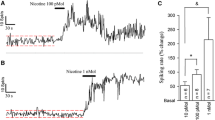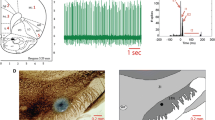Summary
The role of dopamine D1 heteroreceptors located on the axon terminals of striatonigral neurons was investigated. Local infusion of the direct acting, specific dopamine D1 agonist, R-SKF 38393, into the substantia nigra terminal field of antidromically identified neostriatal projection neurons decreased the electrical excitability of these axons. This effect was dose-dependent and could be partially reversed by subsequent infusion of the specific D1 antagonist, R-SCH 23390. In contrast, excitability was not affected by the systemic administration of SCH-23390 (0.3 and 0.6 mg/kg, iv), or the non-specific antagonist haloperidol (0.2 mg/kg, iv). Since activation of the D1 heteroreceptors by R-SKF 38393 decreased excitability, the inability of these antagonists to modify excitability indicates that endogenous dopamine does not tonically activate these receptors. Systemic administration of the indirect acting agonist, amphetamine (1.0 and 5.0 mg/kg, iv) also failed to change terminal excitability suggesting that, even when unnaturally high levels of dopamine are released in the substantia nigra, endogenous dopamine does not affect neostriatal axons terminating in the substantia nigra. Thus it is unlikely that endogenous dopamine modulates neostriatal control of the substantia nigra through these presynaptic terminal D1 heteroreceptors.
Similar content being viewed by others
References
Aiso M, Potter WZ, Saavedra JM (1987) Axonal transport of dopamine D1 receptors in the rat brain. Brain Res 426:392–396
Altar CA and Hauser K (1987) Topography of substantia nigra innervation by D1 receptor-containing striatal neurons. Brain Res 410:1–11
Altar CA and Marien MR (1987) Picomolar affinity of 125I-SCH 23982 for D1 receptors in brain demonstrated with digital subtraction autoradiography J Neurosci 7:213–222
Cheramy A, Leviel A, Glowinski J (1981) Dendritic release of dopamine in the substantia nigra. Nature 289:537–542
Chevalier G, Vacher S, Deniau JM, Desban M (1985) Disinhibition as a basic process in the expression of striatal functions. I. The striato-nigral influence on tecto-spinal/tecto-diencephalic neurons. Brain Res 334:215–226
Diana M, Young SJ, Groves PM (1988) D1 specific agents modulate dopaminergic terminal excitability. Soc Neurosci Abstr 14:
Diana M, Young SJ, Groves PM (1989) Modulation of dopaminergic terminal excitability by D1 selective agents. Neuropharmacology 28:99–101
Di Chiara G, Porceddu ML, Morelli M, Mulas ML, Gessa GL (1979) Evidence for a GABAergic projection from the substantia nigra to the ventromedial thalamus and to the superior colliculus of the rat. Brain Res 176:273–284
Fonnum F, Grofova I, Rinvik E, Storm-Mathisen J, Walberg F. Origin and distribution of glutamate decarboxylase in substantia nigra of the cat.
Gariano RF, Tepper JM, Sawyer SF, Young SJ, Groves PM On the presence of terminal autoreceptors on mesocortical dopamine neurons. Clin Res 34:69A
Graybiel AM and Ragsdale CW (1983) Biochemical anatomy of the striatum. In: Emson PC (ed) Chemical neuroanatomy. Raven Press, New York, pp 427–503
Grofova I (1975) The identification of striatal and pallidal neurons projecting to substantia nigra: an experimental study by means of retrograde axonal transport of horseradish peroxidase. Brain Res 91:286–291
Groves PM, Fenster GA, Tepper JM, Nakamura S, Young SJ (1981) Changes in dopaminergic terminal excitability induced by amphetamine and haloperidol. Brain Res 221:425–431
Groves PM, Linder JC (1983) Dendro-dendritic synapses in substantia nigra: description based on analysis of serial sections. Exp Brain Res 49:209–217
Iorio LC, Barnett A, Leitz FH, Houser VP, Korduba CA (1983) SCH 23390, a potent benzaepine antipsychotic with unique interactions on dopaminergic systems. J Pharmacol Exp Ther 226:462–468
Kirk RE In: Experimental design. (1977) Brooks/Coole Publishing, Belmont CA, Langer SZ (ed) Presynaptic receptors and their role in the regulation of transmitter release. Br J Pharmacol 60:481–497
Mereu G, Westfall TC, Wang RY (1985) Modulation of terminal excitability of mesolimbic dopaminergic neurons by damphetamine and haloperidol. Brain Res 226:155–170
Nakamura S, Tepper JM, Young SJ, Groves PM (1981) Neurophysiological consequences of presynaptic receptor activation: changes in noradrenergic terminal excitability. Brain Res 226:155–170
Paxinos G, Watson C (1982) The rat brain ins stereotaxic coordinates. Academic Press, New York
Reubi J-C, Iversen LL, Jessell TM (1977) Dopamine selectively increases 3H-GABA release from slices of rat substantia nigra in vitro. Nature 268:652–654
Ryan LJ, Tepper JM, Sawyer SF, Young SJ, Groves PM (1985) Autoreceptor activation in central monoamine neurons: modulation of neurotransmitter release is not mediated by intermittent axonal conduction. Neuroscience 15:925–931
Ryan LJ, Young SJ, Groves PM (1989) Substantia nigra stimulation evoked antidromic responses in rat neostriatum. Exp Brain Res 63:449–460
Ryan LJ, Young SJ, Segal DS, Groves PM (1989) Antidromically-identified striatonigral projection neurons in the chronically-implanted, behaving rat: relations of cell firing to amphetamine-induced behaviors. Behav Neurosci 103:3–14
Savasta M, Dubois A, Feuerstein C, Benavides J, Scatton B (1987) Localization pf D1 dopamine receptors in the rat brain by quantitative autoradiography: effect of dopaminergic denervation. Biogenic Amines:419–429
Setler PE, Sarau HM, Zirkle CL, Saunders HL (1978) The central effects of a novel dopamine agonist. Eur J Pharmacol 50:419–430
Spano PF, Trabucchi M, Di Chiara G (1977) Localization of nigral dopamine-sensitive adenylate-cyclase on neurons originating from corpus striatum. Science 196:1343–1345
Starke K (1981) Presynaptic receptors. Ann Rev Pharmacol Toxicol 21:7–30
Starr M (1987) Opposing roles of dopamine D1 and D2 receptors in nigral gamma-[3H]aminobutyric acid release? J Neurochem 49:1042–1049
Tepper JM, Groves PM, Young SJ (1985) The neuropharmacology of the autoinhibition of monoamine release. Trends Pharmacol Sci 6:251–256
Author information
Authors and Affiliations
Rights and permissions
About this article
Cite this article
Ryan, L.J., Diana, M., Young, S.J. et al. Dopamine D1 heteroreceptors on striatonigral axons are not stimulated by endogeneous dopamine either tonically or after amphetamine: evidence from terminal excitability. Exp Brain Res 77, 161–165 (1989). https://doi.org/10.1007/BF00250578
Received:
Accepted:
Issue Date:
DOI: https://doi.org/10.1007/BF00250578




